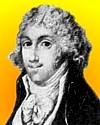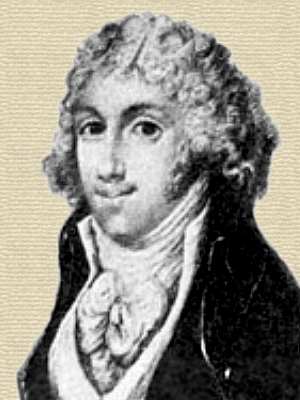 (source)
(source)
|
Lionel Lukin
(18 May 1742 - 16 Feb 1834)
English inventor and pioneer who patented an “unimmergible” (unsinkable) construction for a lifeboat that used airtight compartments and cork, so that small boats would not sink even when filled with water.
|
Lionel Lukin.
from Dictionary of National Biography (1893)
[p.266] LUKIN, LIONEL (1742-1834), inventor of lifeboats, youngest son of William Lukin of Blatches, Little Dunmow, of an old Essex family, by Anne, daughter of James Stokes, was born at Dunmow 18 May 1742. One of his ancestors was Henry Lukyn (1586-1630), who is described by Anthony à Wood as a [p.267] mathematician, and mentioned by Thoroton as having ‘dwelt before the wars at South Holme’ (Hist, of Notts, p. 369). On his mother’s side he was descended from a Lionel Lane, one of Blake’s admirals. Lukin was for many years a fashionable London coach-builder in Long Acre. He became a member of the Coachmakers’ Company in 1767, and did not finally retire from business until 1824. He appears to have been a man of scientific tastes and fertile mechanical genius, and, being a personal favourite of the prince regent and connected with William Windham, secretary of state for war and colonies, had opportunities of bringing some of his inventions into public notice. Among these was an ‘unsubmergible’ boat, He began by making certain alterations in a Norway yawl purchased in 1784, the efficiency of which he tested as far as was practicable in the Thames. On 2 Nov. 1785 he obtained a patent for his ‘improved method of construction of boats and small vessels, for either sailing or rowing, which will neither overset in violent gales or sudden bursts of wind, nor sink if by any accident filled with water’ (patent 1502, completed 1 Dec. 1785). The patent specification explains this is to be accomplished by fitting ‘to the outsides of vessels, of the common or any form, projecting gunnells sic] sloping from the top of the common gunnell in a faint curve towards the water, so as not to interfere with the oars in rowing, and from the extreme projection (which may be greater or less, according to the size and the use which the boat or vessel is intended for) returning to the side in a faint curve at a suitable height above the water-line. These projecting gunnells may be solid, of any light material that will not absorb water, or hollow and watertight, or of cork and covered with thin wood, canvass, tin, or other light metal, mixture or composition. The projections are very small at the stem and stern, and increase gradually to the dimensions required.’ The specification further provides that the inside at stem and stern and the spaces under the seats or thwarts, and if necessary between the timbers, shall be filled up with air-tight and watertight compartments or with cork or other light material that will repel water, whereby ‘the boat or vessel will be much lighter than any body of water it must displace, so that it will with safety carry more than its common burthen, though the remaining space by any accident become filled with water.’ It also provides that the boat or vessel be fitted with a false keel of cast-iron or other metal, which will preserve the bottom and render the vessel stiffer and safer than a greater weight of ballast carried in the ordinary way (ib.) Lukin submitted his invention to the Prince of Wales (George IV), to the Dukes of Portland and Northumberland, Admirals Sir Robert King and Schank, and to Admiral Lord Howe, who ‘gave him strong verbal approbation, but could not be induced to take any official step to further his views.’ By the advice of Captain James, then deputy-master of the Trinity House, Lukin lent his boat, which he named the Experiment, to a Ramsgate pilot, to be tested in rough weather. He heard no more of her than that she had crossed the Channel several times when other boats would not venture out, and, it was suggested, had been confiscated as a smuggler in some foreign port. Lukin built another similar boat, twenty feet in length, and called her the Witch. Her qualities were tested by Sir Sydney Smith and other naval officers, and at Margate Lukin exhibited her superiority in sailing owing to the spread of canvas she could safely carry. But Lukin had to contend with seafaring prejudices, and his ‘unsubmergible boats,’ though they attracted attention, were little in request. Besides one built for the Bamborough Charity, only four were ordered, one of which proved very useful at Lowestoft. In 1790 he published a description of his lifeboat, with illustrations drawn to scale. Some time after the date of Lukin’s patent a ‘lifeboat’ was built (not patented) by Henry Greathead [q. v.], who was rewarded with a parliamentary grant. Lukin declared that Greathead’s boat was ‘in all the essential principles of safety precisely according to my patent, and differing from it in no considerable respect, except the curved head, which contributes nothing to the general principle of safety, but renders it unfit for a sailing-boat.’ In 1806 a Mr. Hailes put forward the claims of Wouldham of Newcastle as an inventor of lifeboats, and Lukin answered in three letters, proving his priority of claim (cf. Gent. Mag. 1806, 621, 819, 1110). These he afterwards published as a pamphlet dedicated to the Prince of Wales.
Lukin also invented a raft for rescuing persons from under ice, which he presented to the Royal Humane Society, and an adjustable reclining bed for patients, which he presented to various infirmaries. He also invented a rain-gauge, and kept a daily record of meteorological observations for many years until his sight failed in 1824.
Lukin died at the age of ninety-two, on 16 Feb. 1834, at Hythe, Kent. A headstone, marking his grave in the parish churchyard, describes him as the ‘inventor of the lifeboat principle.’ A memorial window in the parish [p.268] church was unveiled 3 Oct. 1892. Lukin was twice married, and by his first wife, born Walker, and widow of Henry Gilder of Dunmow, had a daughter and a son of the same name, who patented several inventions, and died in 1839.
[Information kindly supplied by the Rev. C. T. Robinson; Gent. Mag. 1834, ii. 653; Patent Specifications to 1852, in Office of Commissioners of Patents; Memoir by Sir David Brewster in Good Words, x. 688; Notes and Queries, 3rd ser. iv. 303; Lewis’s Hist, of the Lifeboat (1874); Times, 8 Nov. 1890, p. 6. col. 3.]
- 18 May - short biography, births, deaths and events on date of Lukin's birth.
- Lionel Lukin - extract from History of the Life-Boat and Its Work (1874) by Richard Lewis





